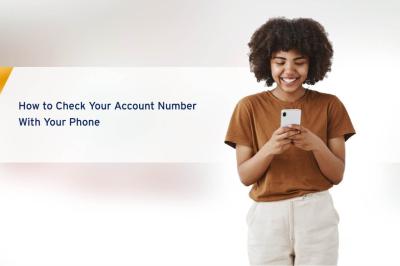How to Check Your Account Number With Your Phone
To ensure secure banking, it is essential to have your account number. However, how can you verify it using your phone? Although your account number is a crucial element for carrying out banking transactions, it is necessary to stress that it is not the only factor in ensuring secure banking.
The security of your banking transactions is dependent on a confluence of circumstances, and various tiers of safeguarding measures are implemented to protect your financial information.
A significant majority of banks utilise multi-factor authentication, which entails the implementation of extra verification measures that go beyond simply providing an account number and password.
This may involve the use of single-use codes or security inquiries transmitted to your mobile device.
Additional crucial safety measures are needed to protect your account number.
The robustness of your passwords has a substantial impact on the security of your banking activities. Employing intricate passwords that incorporate letters, numbers, and symbols enhances the robustness of your security.
Account holders are frequently advised to refrain from using easily predictable information such as birthdays or names.
Here are some safety components you should take into account:
● Tokenization and encryption
Financial organisations employ tokenization and encryption techniques to safeguard sensitive information when conducting online transactions. Tokenization is the process of substituting sensitive information, such as account numbers, with distinct tokens. Encryption, on the other hand, guarantees the secure transmission of data.
● Routine surveillance
Remain watchful by consistently examining your account statements and transaction notifications. Promptly notify your bank of any unauthorised or questionable activity.
● Security of Mobile Applications
When utilising a mobile banking application, make sure to obtain it from a trustworthy source and regularly update the programme. Mobile applications frequently incorporate supplementary security measures, such as biometric authentication, to bolster security.
● Settings for maintaining privacy
Assess and modify the privacy configurations of your online banking accounts. Minimise the extent of personal information that is publicly accessible to others, particularly on social media sites.
● Encrypted Communication Channels
When interacting with your bank, make sure you use secure communication protocols. Refrain from disclosing confidential information via unencrypted email or messaging services.
● Ensure the security of your devices
Make sure that the equipment you use for financial transactions, such as PCs, cellphones, and tablets, is adequately protected. Utilise security measures at the device level, such as Personal Identification Numbers (PINs), passwords, or biometric authentication.
Verify your account number using your mobile device.
To verify your account number using your phone, you have multiple options available, which vary based on your bank and the services it provides.
Here are several typical methods for verifying your account number using your mobile phone:
1. Application for Mobile Banking
Several financial institutions offer mobile banking applications that enable users to access a range of services, such as verifying their account number. Assuming you have already installed the mobile application, proceed by logging in and locating the part that presents your account information.
2. Unstructured Supplementary Service Data (USSD) Code
Multiple financial institutions provide USSD codes that enable users to do banking activities, such as verifying their account number. To retrieve your account number, dial the USSD code specific to your bank and proceed by following the instructions provided.
The bank typically issues the code, and it can vary between different institutions. It is important to be aware that employing this approach may result in additional fees.
3. Mobile banking via SMS
Certain financial institutions provide SMS banking services. To obtain information about your account, including your account number, you can send a particular SMS code to the appropriate number at your bank.
4. Contact the customer service department.
Communicating with your bank’s customer care is a direct way to request information regarding your account number. Make a formal inquiry about your account number and authenticate your identification by calling the customer service hotline that your bank offers.
5. A website for doing banking transactions over the internet.
Utilise the online banking platform of your bank by accessing it through a web browser on your mobile device. Access your account by logging in and then proceed to the part that presents your account details, including your account number.
It is important to keep in mind that the specific ways at your disposal may vary depending on the services provided by your bank.
If you are uncertain or incapable of locating your account number using these methods, it is advisable to reach out to your bank’s customer care for guidance.
Furthermore, it is imperative to adhere to security protocols and refrain from disclosing confidential data to unauthorised parties.
Protecting Your Bank Account Using Your Mobile Device
Ensuring the security of your bank account is crucial in order to safeguard your financial information and thwart any unauthorised entry.
Here are some suggestions on how to bolster the security of your bank account when using your mobile device:
● Employ robust authentication methods
If your bank offers it, activate two-factor authentication (2FA). This usually entails obtaining a single-use code on your mobile phone or another device, in addition to entering your password.
● Ensure the security of your mobile device
Configure a secure lock screen on your mobile device using a robust personal identification number (PIN), password, or biometric verification such as fingerprint or face recognition. This provides an additional level of security in the event that your phone is misplaced or stolen.
● Download and install the authorised banking applications
Exclusively acquire and set up authorised banking applications just from reputable sources, such as the Apple App Store or Google Play Store. Refrain from utilising external applications that purport to offer financial services.
● Ensure that both applications and the operating system are regularly updated.
Ensure that you frequently update the operating system and banking applications on your phone. Updates frequently incorporate security patches that specifically target vulnerabilities and improve overall security.
● Exclusively utilise a Wi-Fi connection that is secure.
Refrain from performing financial transactions while connected to public Wi-Fi networks. Utilise a Wi-Fi connection that is both safe and password-protected, or alternatively, contemplate employing a virtual private network (VPN) to enhance the level of security.
● Exercise caution regarding phishing attempts
Exercise caution when receiving emails, messages, or calls that solicit your banking information. Financial institutions generally do not request sensitive information through unsolicited communication. Prior to disclosing any information, confirm the legitimacy of any communication from your bank.
● Regularly monitor your account.
Monitor your account transactions vigilantly. Establish notifications for atypical or substantial transactions, and routinely examine your bank statements. Promptly notify your bank of any unauthorised transactions.
● Log out at the end of each session.
It is imperative to always log out of your banking application or website once you have finished your transactions. This serves to hinder unauthorised entry, particularly when utilising a device that is shared or accessible to the public.
● Protect Your Email Account
It is crucial to protect the security of your email account because a sizable portion of financial communications take place via email. Utilise a robust password, use two-factor authentication, and consistently assess your email security configurations.
● Activate Biometric Authentication
If both your phone and banking app have the capability to use biometric authentication, such as fingerprint or facial recognition, it is advisable to activate this feature. Biometrics provide an additional level of security and convenience.
● Acquire knowledge and information through self-learning.
Keep yourself updated on the most recent security vulnerabilities and optimal methods. Exercise caution with prevalent fraudulent schemes and phishing methods in order to prevent being a victim of deception.
By adhering to these guidelines, you may greatly improve the security of your bank account while utilising your mobile device. Exercising initiative and staying watchful are crucial for protecting your financial information and preventing unauthorised entry.
Guidelines for Disclosing Your Account Number on the Internet
Disclosing your account number on the internet has a certain degree of danger, and it is crucial to adhere to specific guidelines in order to safeguard your financial data and reduce the likelihood of unauthorised entry or fraudulent activity.
Below are the guidelines for disclosing your account number over the internet:
● Refrain from using public platforms.
Refrain from disclosing your account number on public platforms such as social media, forums, or public chat groups. These platforms lack sufficient security measures, making them vulnerable to unauthorised access by hostile individuals.
● Utilise secure communication channels
When disclosing your account number, use secure and confidential communication channels. Private messaging or confidential communication features inside trustworthy applications can provide greater security than public forums.
● Restrict the sharing of information to individuals who are considered reliable and trustworthy.
Only disclose your account number to individuals or institutions that you trust. Refrain from disclosing this information to unfamiliar or unverified individuals, even if they assert to be affiliated with a reputable institution.
Exercise caution when dealing with emails and messages.
Exercise prudence while disclosing your account number over email or messaging applications. Authenticate the identity of the individual or entity seeking the information and exercise caution over any phishing endeavours.
● Explore secure payment applications.
If feasible, utilise secure payment applications that enable you to transfer and receive funds without explicitly disclosing your account number. These applications frequently include supplementary security protocols, such as encryption and two-factor authentication.
● Acquire knowledge about fraudulent activities
Stay updated on prevalent scams and deceitful practices that specifically target individuals who disclose their account numbers online. Exercise caution when receiving unsolicited requests for your financial information.
● Verify the identity of the recipient.
Prior to disclosing your account number for a transaction, ensure that you confirm the recipient’s identification. Verify the authenticity of the business or individual you are interacting with.
● Exercise caution when taking screenshots.
Refrain from disclosing your account number by means of screenshots, particularly on platforms where screenshots can be readily taken and distributed. Confidential data might be inadvertently revealed.
● Evaluate and adjust privacy configurations
Consistently evaluate and modify the privacy configurations on your social media profiles and other internet sites. Restrict the accessibility of personal information to exclusively reliable contacts.
● Notify authorities of any suspicious behaviour or actions observed.
If you observe any dubious behaviour associated with your account or have reason to believe that your personal data has been breached, promptly tell your bank or the appropriate authorities.
Keep in mind that your account number is confidential and should be shared carefully. It is crucial to always give priority to security and remain watchful in order to safeguard yourself against possible fraud or unauthorised entry into your financial accounts.



